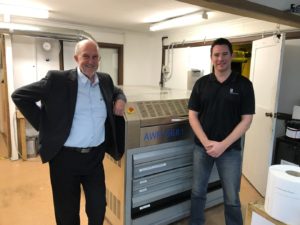Asahi Photoproducts water-washable platemaking system boosts quality and productivity
 Asahi Photoproducts, a pioneer in flexographic photopolymer plate development, has recently reported that Label Partners, a leading producer of quality labels for industries, has acquired an Asahi Photoproducts AWPTM 2530 Combi all-in-one water-washable plate processor, for use with Asahi AWPTM-DEF flexo plates. The Southern Australian company produces labels for companies in the wine, food and beverage, fresh produce including poultry and dairy, automotive, pharmaceutical and chemical sectors.
Asahi Photoproducts, a pioneer in flexographic photopolymer plate development, has recently reported that Label Partners, a leading producer of quality labels for industries, has acquired an Asahi Photoproducts AWPTM 2530 Combi all-in-one water-washable plate processor, for use with Asahi AWPTM-DEF flexo plates. The Southern Australian company produces labels for companies in the wine, food and beverage, fresh produce including poultry and dairy, automotive, pharmaceutical and chemical sectors.
David McCloud, managing director, Label Partners, said, “We have always been at the forefront of narrow web Flexo and have grown our business dramatically over the past six years by using quality equipment and helping to pioneer water-wash plate technology in Australia. We were the first company in Australia to embrace the Asahi AWP system. The resulting cost-effective, but very high quality digital plates consistently achieve a print result that compares favourably against most offset labels seen in the wine label market.”
Shane Gillespie, production manager, Label Partners, added, “Since the installation of the Asahi AWP processor, the quality and consistency of our platemaking equipment has completely streamlined the process of plate to press. Not only are we achieving amazing print results, but we now have a processor that, in our opinion, is able to produce plates of any level with minimum effort. It is extremely reliable, very functional and easy to maintain. The machine is so intelligent, if there is ever anything wrong it shows where on the machine the problem is and it can easily be identified and corrected. This unit consistently produces perfect printing plates time after time. Plus, it has cut our plate processing times in half.”
Asahi plates incorporate Pinning Technology for clean transfer. It is a flexographic plate technology specifically engineered by Asahi that features low plate surface energy that transfers all remaining ink to the printed substrate. Compared to conventional plates, this reduces press-cleaning stops, creating a significant profitability improvement. These plates deliver very high resolution with fine screen rulings and minimum dots fading out to zero, allowing a broader total colour gamut to be achieved, providing more design flexibility and enhanced graphic quality.

